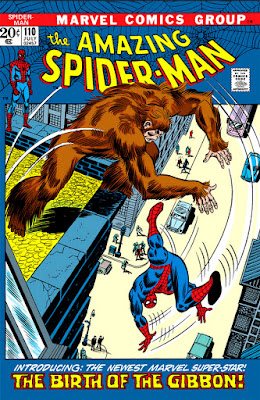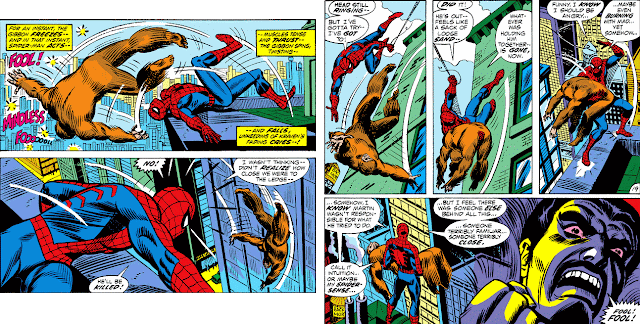The July 1972 issue of Amazing Spider-Man would be the curtain call* for longtime writer Stan Lee on the series, having scripted Spidey's book since 1963 in addition to the character's introduction in Amazing Fantasy the previous year. Although a two-part story, the August issue would serve to usher in the book's new regular writer, Gerry Conway, beginning a distinguished run himself of over three years. There was little notice of Lee's departure from ASM, aside from words mentioned via a letters page response in Part Two (though frankly I was more delighted while looking back at these issues to spot a letter in Part One from future Marvel writer David Michelinie, all of 24 years old at the time)--as well as a more generalized Stan's Soapbox column in a subsequent issue where Lee would formally pass the torch to new editor Roy Thomas and the company's other writers.
It seemed that Lee had opted for more of a smooth transition for Marvel readers than any thoughts of fanfare. And that being the case, how appropriate it seemed that in his final issue he would introduce a rather unremarkable character--a young man hoping for a chance at better things for himself as well as a life without despondency and, worst of all, ridicule. It seemed equally appropriate that, of all the people in New York City, Martin Blank would cross paths with Peter Parker, whose own life during this time had its share of turmoil and whose run of bad luck causes him to hurl his customized camera away in a flash of anger.
*Lee would again be spotlighted in an informal encore the following year, when his story from the 1968 issue of the Spectacular Spider-Man magazine was recycled into a three-part tale for which Conway provided additional dialog.
Martin's acrobatic skill is our tip-off to the character on the issue's cover--but why would this orphaned young man adopt a costumed identity as an ape-man? We would find the answer as he sought employment--and acceptance--in an environment which would unfortunately echo the deriding laughter that followed him all through his childhood.
Martin apparently has chosen to view his chance meeting with Spider-Man as a door opening for himself at last. Yet he's chosen not to hear the words of someone who knows first-hand that being a costumed hero is no guarantee of a life free of rejection or personal burden--and what happens next will not only bring Martin to arguably the lowest point in his life, but also leave him vulnerable to the influence of someone who won't hesitate to take advantage of his circumstances in order to put an end to a despised enemy.
On a better day, Spider-Man might have been more sympathetic to Martin--but his aunt's recent disappearance has added to a sea of troubles he's been experiencing lately, sapping him of his patience and having him regarding Martin as a distraction that he doesn't have time for. With his departure from the scene, however, the time is ripe for this story's principal antagonist to salvage what's left of Martin's fragile self-respect, and direct him to do what he himself cannot, at present.
A curious reversal of story credits in terms of the writer/artist billing, though few would deny that John Romita Sr. (who inks his own work here) isn't deserving of the laurels. While the duties of both Romita and Conway would be listed separately in the following issue, the order would remain the same until issue #120, when artist Gil Kane would again be brought in to replace Romita on pencils. As a side note, this would be the first we'd see of the "Stan Lee presents" preface, which would be relocated to the splash page banner in two issues where it would remain indefinitely.
As for Kraven, he rejoins the book relatively quickly since his last appearance, where he battled Ka-Zar and was sent plummeting off a cliff as a result. Thinking quickly, he was able to slow his descent enough to avoid fatal impact with the ground--but it's been slow-going for the arm injury he continues to nurse, a circumstance which has necessitated his approaching Martin.
Convincing Martin that they each have a reason to hate Spider-Man, the two join forces--and back at his hideout at (where else?) the Botanical Gardens, Kraven proceeds to condition his new partner, both with training and a regimen of herbal potions which will "transform" him, the details of which Kraven hasn't been forthcoming. But while Martin begins to balk at the way that Kraven regards him, as if he was something other than human, he nevertheless ingests the final cup--and unfortunately confirms his fears about what Kraven intends for him.
But there is a side effect which Martin was left in the dark about--a method of ensuring success concerning their plans for Spider-Man, in a confrontation which Kraven realizes will degrade Martin's humanity until only "the Gibbon" remains.
Meanwhile, Spider-Man's efforts to locate his missing aunt continue to prove futile, leaving him desperate and distracted--and despite his spider-sense, he's caught off guard by the sudden, fierce attack of the Gibbon, whose savagery this time could well prevail considering the identity of the one whose commands now burn in his mind.
With the collapse of his plan, Kraven is forced to stew in his juices, while Spider-Man proceeds to bring Martin to a hospital for care (take that to mean dropping him off at a hospital and telling a startled nurse the man's name before swinging off). Considering the mental state that Martin is in, we can only guess at how agitated he'll likely be when he's eventually discharged and billed for services rendered, considering that he was at the end of his rope financially when Kraven found him. Today is not your day for winning friends, Mr. Parker.






















3 comments:
I always liked this guy. Glad writers in the last 20 years or so have given him a more heroic lot in life. By the way, we have heard a lot for many years about Lee being a shameless self promoter at the expense of other talented people. His humble exit from the greatest writing career in comic history seems to directly contradict that and makes you wonder about the people trying to bring the man down...
Well, if this was Stan's swan song on ASM, he certainly left on a note of pathos. I would say that his last story was unconventional, but for Marvel at the time it really wasn't. Marvel Comics by this time had many antagonists who were tragic figures, almost more to be pitied than anything else.
That was intentional, I think. It seems like much of the time Stan wanted villains who were made and not born as such.
M.P.
An excellent observation, M.P. Come to think of it, a collection of Lee's characters who fit into that description would make a nice "scrap-post" one of these days--though as you note, it might be too daunting a task to track them all down! ;)
Post a Comment